- About us»
- Net income calculator»
- Population aging»
-
- Least developed regions»
-
- Average wage
- Material need benefits
- Meal allowance
- Counties of Slovakia
- Inflation
- Living and Subsistence Minimum
- Unemployment of Czechia and Slovakia
- NACE Classification
-
- Life expectancy
- Gender differences
- Youth unemployment and NEET
- Minimum wage in EU
- Unemployment rates of different age groups
- Share of salaries on GDP
- Employment rate
- Percentage of employees ususally working at nights
- NEET
- Long term unemployment
- Unemployment rate
-
- Bratislava and surroundings
- Kopanice
- Danube river
- lower Vah river
- middle Vár river
- upper Nitra river
- lower Nitra river
- Mining cities
- Kysuce a Orava
- upper Vah river - Liptov
- Spiš cities
- upper Hron river
- Juhoslovenská kotlina
- Košice fold and Torysa river
- upper Zemplín
- lower Zemplín
- EU regions
- NUTS3 regions of Slovakia
- LAU1 dataset
-
- Projects and activities
- Inclusive growth»
- Good work
- Project SKRS
- Social system – reality and vision
-
- Education of unemployed
- Young unemployed not taking part in education
- Proposal to change the system of education funding
- Library
- News»
- Contact
Transdanubia – HU2
EU regions: Hungary > Transdanubia
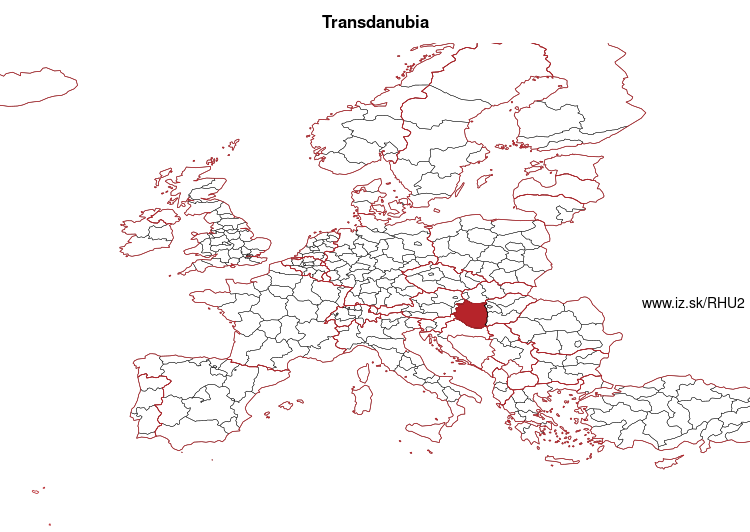
| Indicator | Period | Value |
|---|---|---|
| Life long learning | ||
| life long learning participation | 2024 | 9.2 |
| Part time jobs and flexible employment | ||
| percentage of part time workers | 2024 | 4.78 |
| percentage of part time workers, men | 2024 | 2.6 |
| percentage of part time workers, women | 2024 | 7.27 |
| Gender differences | ||
| gender gap in employment rate | 2024 | 90.39 |
| gender gap in unemployment rate | 2024 | 90.91 |
| Graduates and young people | ||
| unemployment rate of youth with elementary education | 2024 | 36.6 |
| NEET | 2024 | 9.3 |
| Gross domestic product | ||
| GDP per capita in PPS of EU average | 2023 | 62 |
| Employment | ||
| employment rate | 2024 | 75.4 |
| Social exclusion | ||
| people at risk of poverty or social exclusion | 2020 | 15.8 |
| job vacancies rate | 2025q2 | 2.1 |
More on wikipedia wikidata Q840562 on OpenStreetMap Transdanubia slovensky: HU2
Subregions: Central Transdanubia, Western Transdanubia, Southern Transdanubia
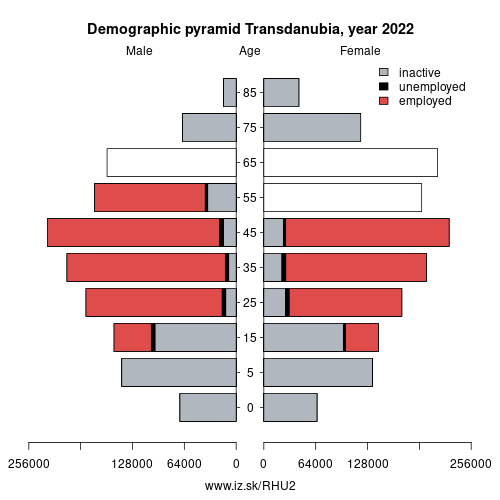
Unemployment
| Indicator | Period | Value |
|---|---|---|
| Unemployment | ||
| unemployment rate | 2024 | 4.2 |
| youth unemployment rate | 2024 | 13.7 |
| Long term unemployment | ||
| long term unemployment | 2024 | 1.3 |
| share of long term unemployed | 2024 | 31.9 |
| Unemployment according to labour offices | ||
| number of registered unemployed | October 2025 | 58 312 |
| number of unemployed women | October 2025 | 29 426 |
| number of vacancies | October 2025 | 24 753 |
Comparison of unemployment according to ILO methodology and registered unemployment yields some differences.
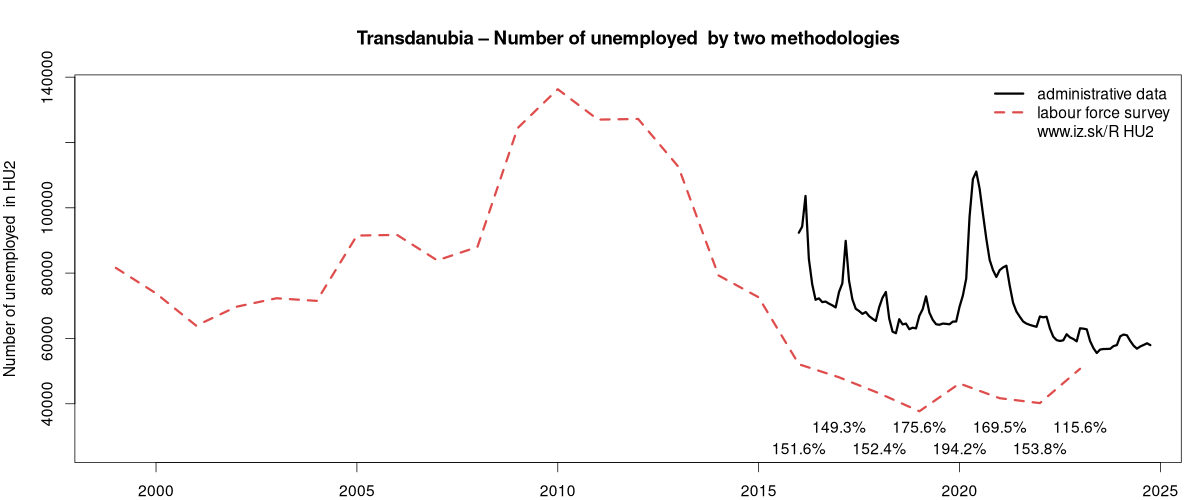
Data on unemployment in counties of Transdanubia are available at Local Administrative Units data of Visegrad countries.
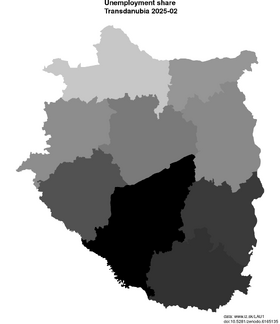
Demographics
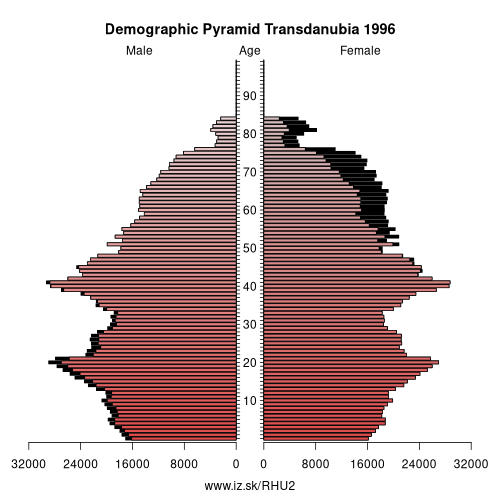
| Indicator | Period | Value |
|---|---|---|
| Demographics | ||
| number of inhabitants | 2024 | 2 891 292 |
| population density | 2023 | 81.3 |
| old-age dependency ratio | 2024 | 33.6 |
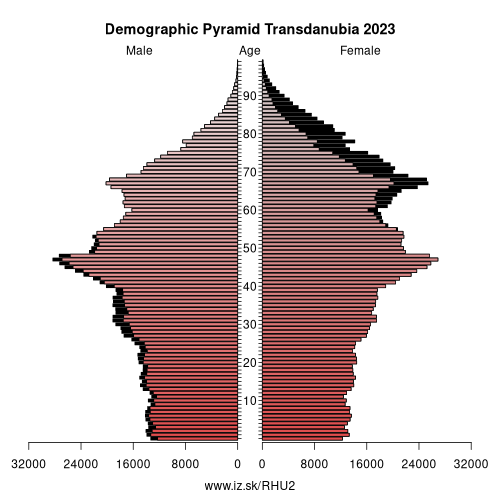
Employment by sectors, Transdanubia
| NACE r2 | % | NACE r2 | % | ||
|---|---|---|---|---|---|
| A | 66.8 | 5% | B-E | 405.3 | 29% |
| F | 120.9 | 9% | G-I | 317.8 | 23% |
| J | 25.5 | 2% | K | 19.2 | 1% |
| L | 8.4 | 1% | M_N | 86.4 | 6% |
| O-Q | 292 | 21% | R-U | 59.8 | 4% |
| TOTAL | 1402.1 | 100% |
Data for the period year 2024. Source of the data is Eurostat, table [lfst_r_lfe2en2].
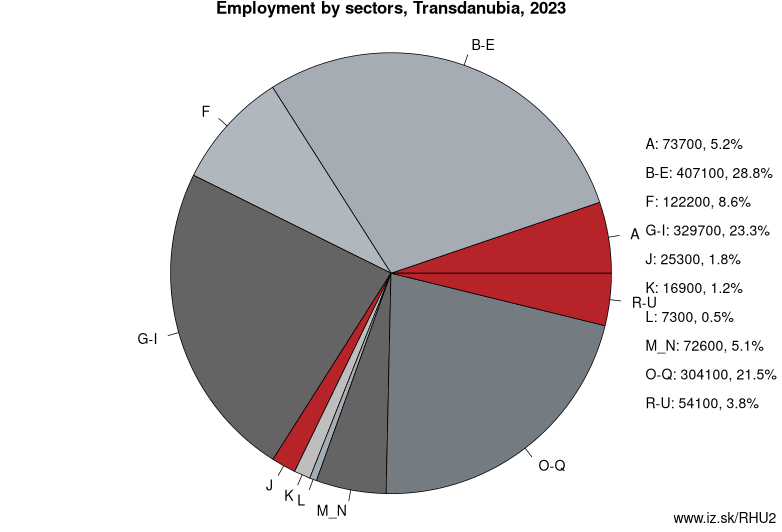
From Wikipedia: Transdanubia (Hungarian: Dunántúl; German: Transdanubien, Polish: Transdanubia; Croatian: Prekodunavlje or Zadunavlje, Slovak: Zadunajsko, Czech: Zadunají) is a traditional region of Hungary. It is also referred to as Hungarian Pannonia, or Pannonian Hungary.
Administrative divisions
Traditional interpretation
The borders of Transdanubia are the Danube River (north and east), the Drava and Mura rivers (south), and the foothills of the Alps roughly along the border between Hungary and Austria (west).
Transdanubia comprises the counties of Győr-Moson-Sopron, Komárom-Esztergom, Fejér, Veszprém, Vas, Zala, Somogy, Tolna, Baranya and the part of Pest that lies west of the Danube. (In the early Middle Ages the latter was known as Pilis county.)
This article deals with Transdanubia in this geographical meaning.
Territorial changes
While the northern, eastern and southern borders of the region are clearly marked by the Danube and Drava rivers, the western border was always identical with the political boundary of Hungary, therefore it was affected by the territorial changes of the 20th century. Before the Treaty of Trianon in 1920 the present-day regions of Burgenland, Prekmurje and Međimurje were integral parts of Transdanubia. The three villages of Rusovce, Jarovce and Čunovo also belonged to Transdanubia before the Paris Peace Treaty in 1947. Transdanubia is essentially a Hungarian geographical concept so these areas ceased to be parts of it when they were annexed by neighbouring countries.
EU regions
Transdanubia is a NUTS territorial unit in the European Union, consisting of Central Transdanubia, Western Transdanubia and Southern Transdanubia (see NUTS:HU). Pest county and Budapest belong to the region of Central Hungary.
Other: Hungary, Great Plain and North, Central Hungary, Transdanubia
Neighbours: HRVATSKA, Slovenia, East Austria, Central Hungary, Slovakia, Great Plain and North
Subregions: Central Transdanubia, Western Transdanubia, Southern Transdanubia
Suggested citation: Michal Páleník: Europe and its regions in numbers - Transdanubia – HU2, IZ Bratislava, retrieved from: https://www.iz.sk/PHU2, ISBN: 978-80-970204-9-1, DOI:10.5281/zenodo.10200164
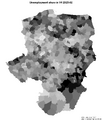
Local Administrative Units data of Visegrad countries
Statistical data on LAU1 regions of Slovakia, Czechia, Poland, Hungary. This LAU1 panel data dataset on 556 regions contains data on population, age structure of inhabitants, on number and structure of unemployed and is regularly updated.. . .
Similar articles
Regions of the European Union, Regions of the Slovak Republic, Changes in the LAU1 dataset, Vacancies, Unemployment structure in the Visegrad region, Local Administrative Units data of Visegrad countries, Labour market indicators of slovak regions., Counties of Slovakia, Unemployment of Czechia and Slovakia

 Share
Share Facebook
Facebook Twitter
Twitter News
News